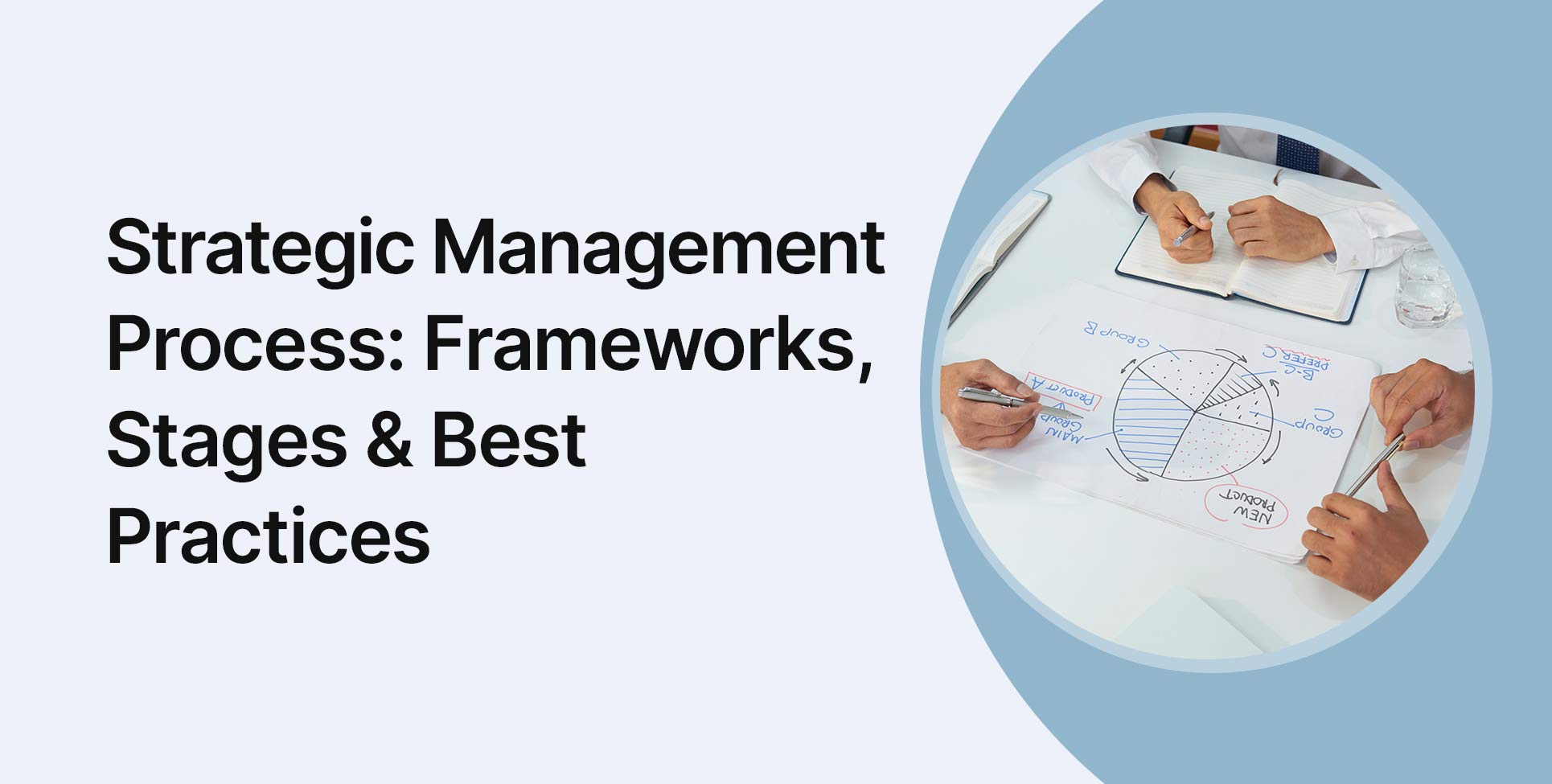Most organizations have business strategies yet 90% fail to execute them successfully. The gap between strategic ambition and actual results destroys value, frustrates stakeholders and leaves companies vulnerable to disruption from more disciplined competitors.
The strategic management process bridges this execution gap by providing structured approaches for translating vision into reality. Companies that master this discipline consistently outperform peers, adapting to change while maintaining clear direction toward long-term organization's goals.
This guide reveals proven methodologies for developing and implementing your strategic plan effectively. You'll discover frameworks, overcome common challenges and learn best practices that transform strategy from a theoretical exercise into competitive advantage.
{{banner-3="/banner-page"}}
What is the strategic management process?
The strategic management process is a systematic approach organizations use to define their direction, make decisions and allocate resources to achieve long term success. This framework analyzes internal and external factors to create a sustainable competitive environment while adapting to market trends and emerging technologies.
Unlike routine business processes that maintain daily operations, strategic management focuses on future positioning and organizational transformation. It integrates planning, implementation and evaluation into a continuous cycle that aligns every department, team and individual with overarching goals while remaining flexible enough to respond to unexpected challenges.
Importance of the strategic management process
Companies with a robust strategic management process consistently outperform those relying on reactive decision-making. The structured approach transforms ambiguous visions into action plans, creating measurable value across financial, operational and competitive dimensions that shape ambitious goals.
Business performance impact
Companies implementing formal strategic planning report 12% higher profitability and 17% faster growth than those without structured approaches. The strategic management process creates alignment between resources and objectives, eliminating waste while focusing investments on initiatives that drive measurable returns. This disciplined approach turns strategy from abstract concepts into concrete results.
Competitive advantage creation
Strategic management identifies unique market positions that competitors cannot easily replicate. By systematically analyzing industry dynamics and internal environments, companies discover differentiation opportunities that operational management alone would miss. Modern strategic planning software helps track organization's strengths and adapt strategies in real-time, maintaining market leadership through proactive positioning.
Risk mitigation and opportunity capture
The strategic management process anticipates potential disruptions before they impact operations, allowing corporations to prepare contingency plans and allocate resources efficiently. This forward-looking approach identifies emerging opportunities early, positioning companies to capitalize on market shifts while competitors remain focused on current challenges.
Top 3 frameworks for a strategic management process
Successful strategic management process execution requires structured frameworks that guide analysis and decision-making. These proven methodologies transform complex information into actionable insights, helping organizations navigate from the current state to the desired future while maintaining clarity throughout the journey.
Internal and external environment analysis (SWOT)
SWOT analysis provides comprehensive situational awareness by examining strengths, weaknesses, opportunities and threats across boundaries. This strategic management framework bridges plan formulation with reality by mapping internal capabilities against external market conditions. Organizations use SWOT findings to identify priorities that leverage advantages while addressing vulnerabilities before they become critical issues.
How it works:
- List internal strengths and weaknesses through capability audits and performance reviews
- Identify external factors and threats via market research and competitive intelligence
- Create strategic initiatives that match strengths with opportunities while mitigating threat-weakness combinations
Macro-environmental scanning framework (PESTEL)
PESTEL analysis examines political, economic, social, technological, environmental and legal factors shaping industry dynamics. This framework prevents strategic blind spots by systematically evaluating external resources beyond immediate competitive pressures. Companies integrate PESTEL insights into long-range planning, ensuring strategies remain viable despite shifting macro conditions affecting entire markets.
How it works:
- Monitor regulatory changes, economic indicators and social trends affecting your industry
- Assess technological disruptions and environmental regulations impacting business models
- Update assessments quarterly to capture emerging trends before they reach inflection points
Performance measurement system (Balanced Scorecard)
The Balanced Scorecard translates abstract strategies into measurable objectives across financial, customer, internal process and learning perspectives. This strategy management framework ensures strategy implementation success by creating clear accountability and progress tracking mechanisms. Companies achieve strategic alignment when every team member understands how their work contributes to scorecard metrics and overall vision.
How it works:
- Define strategic objectives and metrics for each of the four perspectives
- Cascade scorecards from corporate to departmental to individual levels
- Review performance monthly and adjust tactics while maintaining strategic direction
The 5 stages of strategic management
The strategic management process unfolds through five interconnected stages that transform vision into reality. Each stage builds upon previous insights while feeding forward into subsequent phases, creating a continuous cycle of strategic evolution and organizational adaptation.
1. Environmental scanning and analysis
Internal assessment (SWOT): Evaluate organizational strengths and weaknesses across all functions, identifying resources and capabilities that differentiate your business. This reveals your company's core competencies and performance gaps.
External analysis (PESTEL): Examine macro-environmental forces including political, economic, social, technological, environmental and legal factors that shape industry dynamics and influence strategic options available to organizations.
Competitive landscape review: Map direct and indirect competitors, analyzing their strategies, market positions and performance to identify opportunities for differentiation and potential competitive threats requiring strategic response.
2. Strategy formulation
Vision and mission development: Create compelling statements that articulate long-term aspirations in the business context, providing direction for strategic planning while inspiring stakeholder commitment to shared goals.
Goal setting and objectives: Transform vision into specific, measurable targets with clear timelines and accountability. Well-defined objectives bridge abstract strategy with concrete actions teams can execute daily.
Strategic alternatives evaluation: Generate and assess multiple strategic options using criteria like feasibility, risk and alignment with capabilities. Choose approaches that maximize competitive advantage while minimizing resources required.
3. Strategy implementation
Resource allocation: Distribute financial, human and technological resources according to key priorities, ensuring critical initiatives receive sufficient support while maintaining operational excellence across the organization.
Organizational structure alignment: Redesign reporting relationships, decision rights and workflow processes to support strategy execution. Structure should enable rather than hinder the strategic management plan's successful deployment.
Communication and change management: Develop comprehensive programs that build understanding, acceptance and enthusiasm for strategic changes throughout the organization, addressing resistance while celebrating early wins that build momentum.
4. Strategy evaluation and control
Performance measurement: Track progress using balanced metrics that capture financial and non-financial outcomes. Integrate performance rating scale tools to assess individual contributions to strategic objectives.
Milestone tracking: Monitor achievement of critical checkpoints that indicate whether strategy implementation remains on schedule. Early detection of deviations enables corrective action before problems become critical.
Feedback mechanisms: Establish systems for gathering insights from employees, customers and partners about strategy effectiveness. Regular feedback loops ensure strategies remain relevant despite changing conditions.
5. Strategic adjustment and renewal
Continuous improvement: Refine strategies based on performance data and market feedback, making incremental adjustments that enhance effectiveness without disrupting successful initiatives already generating positive results.
Pivoting strategies: Recognize when fundamental assumptions prove incorrect and boldly redirect resources toward new opportunities. Successful pivots preserve organizational strengths while abandoning failing approaches quickly.
Learning integration: Capture lessons from both successes and failures, embedding knowledge into organizational processes that improve future strategic management process cycles and decision-making capabilities.
Challenges in strategic management and how to avoid them
Strategic management faces predictable obstacles that derail even well-crafted plans. Understanding these common pitfalls and their solutions enables organizations to navigate difficulties proactively, maintaining momentum toward strategic objectives despite inevitable setbacks and complications.
Implementation gaps
Brilliant strategies fail when companies cannot translate high-level plans into operational management actions. Disconnects emerge between strategic intent and daily execution, leaving employees confused about priorities while initiatives stall without clear ownership or accountability mechanisms.
Solution: Create detailed implementation roadmaps that break strategies into quarterly milestones and weekly tasks. Assign specific owners to each initiative and establish regular review cycles that connect strategic planning process outputs with operational dashboards tracking actual progress.
Resource constraints
Organizations often discover their ambitions exceed available resources, forcing difficult tradeoffs between strategic initiatives and maintaining current operations. Limited budgets, talent shortages and competing priorities dilute focus, preventing any single strategy from receiving sufficient investment.
Solution: Prioritize ruthlessly by identifying initiatives with the highest strategic impact and feasibility. Phase implementations to generate early wins that fund subsequent stages, and consider partnerships or outsourcing to access capabilities without permanent resource commitments.
Market uncertainty
Rapid changes in the business environment invalidate assumptions underlying carefully developed strategies. Technological disruptions, regulatory shifts, and competitive moves create volatility that makes long-term planning feel futile when the organization's strategy requires constant revision.
Solution: Build flexibility into strategic management plans through scenario planning and regular refresh cycles. Develop adaptive capabilities that enable quick pivots while maintaining core strategic direction, treating uncertainty as an opportunity rather than a threat to strategic success.
Best practices to implement the strategic management process
Successful strategic management requires disciplined execution combined with organizational flexibility. These proven practices help companies navigate complexity while maintaining strategic focus, ensuring initiatives deliver intended results rather than becoming abandoned planning exercises gathering dust on shelves.
Build stakeholder coalition early
Engage key stakeholders before finalizing strategies to secure buy-in and surface potential resistance. The strategic management process succeeds when leaders, employees and external partners understand their roles in execution. Early involvement creates ownership, transforming skeptics into champions who actively drive implementation rather than passively waiting for direction from above.
Create feedback loops between strategy and operations
Establish mechanisms that connect strategic planning with daily operations, ensuring real-world insights inform strategy adjustments. Regular reviews of internal and external factors prevent strategies from becoming outdated. Integrate management by objectives frameworks that cascade strategic goals into departmental targets, creating clear line-of-sight from individual contributions to business success.
Maintain strategic discipline with tactical flexibility
Commit to strategic direction while remaining agile in execution methods. Organizations should protect fundamental principles from constant revision while experimenting with different implementation approaches. This balance prevents strategy churn that confuses employees while avoiding rigid adherence to failing tactics that compromise objectives despite changing conditions.
Conclusion
The strategic management process transforms businesses from reactive entities into proactive market leaders. By following structured stages and proven frameworks, companies create sustainable advantages that compound over time rather than eroding under competitive pressure.
Success requires commitment beyond initial planning sessions. Organizations need to embed strategic thinking into daily operations, creating cultures where every decision aligns with long-term objectives while maintaining flexibility to adapt when conditions change unexpectedly.
Start implementing these practices incrementally, building capabilities that strengthen with each strategic plan cycle. Your investment in strategic management disciplines today determines whether your organization leads or follows in tomorrow's competitive landscape.


